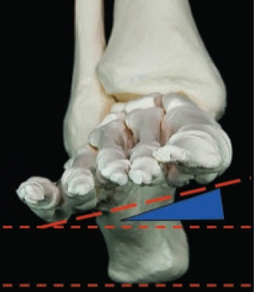

VASYLI矫形鞋垫附加物-VASYLI用于矫形前足内翻(外翻)楔形垫
VASYLI矫形鞋垫附加物——除了广泛使用的VASYLI定制矫形鞋垫外,VASYLI还提供一些产品,比如楔形垫和后跟提升垫,来解决一些特殊的问题,比如前足外翻畸形或马蹄足病。
VASYLI用于矫形前足内翻楔形垫:
要通过矫形鞋垫矫形前足内翻,首先要测量前脚内翻角度。是当距下关节中立时,前足的足底平面相对于后足的足底平面而言。
如果前足内翻角度为4度,则将VASYLI用于矫形前足内翻楔形垫张贴在足底跖骨下面4度处,第一跖骨头部附近的楔块为最厚部分。

VASYLI用于矫形前足外翻楔形垫:
如果足部前外翻异常,则要测量前脚内翻角度。是当距下关节中立时,前足的足底平面相对于后足(地面)的足底平面外翻的角度。
如果前足外翻角度为6度,则应在足底跖骨下方6度处张贴VASYLI用于矫形前足内翻楔形垫,楔形体最靠近第五跖骨头的部分应为最厚部分。

原装进口
| VASYLI矫形鞋垫附加物——VASYLI用于矫形前足内翻(外翻)楔形垫 | 电邮询价 |
VASYLI ORTHOTIC ADDITIONS——VASYLI FOREFOOT POSTING FOREFOOT VARUS(VALGUS) In addition to our wide range of orthotics, we offer products—such as wedges and heel raises—to address specific problems, such as a forefoot valgus abnormality or equinus condition. VASYLI FOREFOOT POSTING FOREFOOT VARUS To manage forefoot varus with an orthotic addition, first measure the forefoot varus angle. This is where the plantar plane of the forefoot is inverted relative to the plantar plane of the rearfoot when the subtalar joint is in neutral. If the angle of the forefoot varus is 4 degrees, the forefoot would be posted at 4 degrees under the plantar metatarsal area with the thickest part of the wedge proximal to the first metatarsal head. VASYLI FOREFOOT POSTING FOREFOOT VALGUS: If the foot has a forefoot valgus abnormality, measure the angle—where the plantar plane of the forefoot is everted relative to the plantar plane of the rearfoot (ground) when the subtalar joint is in neutral. If the angle of forefoot valgus is 6 degrees, the forefoot should be posted at 6 degrees under the plantar metatarsal area with the thickest part of the wedge proximal to the fifth metatarsal head. IMPORTANT: Forefoot wedging techniques as noted above are based on an “ideal rearfoot” with no deformity. VASYLI ORTHOTIC ADDITIONS——VASYLI FOREFOOT POSTING FOREFOOT VARUS(VALGUS) Email for Quotation
VASYLI ORTHOTIC ADDITIONS——VASYLI FOREFOOT POSTING FOREFOOT VARUS(VALGUS) In addition to our wide range of orthotics, we offer products—such as wedges and heel raises—to address specific problems, such as a forefoot valgus abnormality or equinus condition. VASYLI FOREFOOT POSTING FOREFOOT VARUS To manage forefoot varus with an orthotic addition, first measure the forefoot varus angle. This is where the plantar plane of the forefoot is inverted relative to the plantar plane of the rearfoot when the subtalar joint is in neutral. If the angle of the forefoot varus is 4 degrees, the forefoot would be posted at 4 degrees under the plantar metatarsal area with the thickest part of the wedge proximal to the first metatarsal head. VASYLI FOREFOOT POSTING FOREFOOT VALGUS: If the foot has a forefoot valgus abnormality, measure the angle—where the plantar plane of the forefoot is everted relative to the plantar plane of the rearfoot (ground) when the subtalar joint is in neutral. If the angle of forefoot valgus is 6 degrees, the forefoot should be posted at 6 degrees under the plantar metatarsal area with the thickest part of the wedge proximal to the fifth metatarsal head. IMPORTANT: Forefoot wedging techniques as noted above are based on an “ideal rearfoot” with no deformity. VASYLI ORTHOTIC ADDITIONS——VASYLI FOREFOOT POSTING FOREFOOT VARUS(VALGUS) Email for Quotation
VASYLI ORTHOTIC ADDITIONS——VASYLI FOREFOOT POSTING FOREFOOT VARUS(VALGUS) In addition to our wide range of orthotics, we offer products—such as wedges and heel raises—to address specific problems, such as a forefoot valgus abnormality or equinus condition. VASYLI FOREFOOT POSTING FOREFOOT VARUS To manage forefoot varus with an orthotic addition, first measure the forefoot varus angle. This is where the plantar plane of the forefoot is inverted relative to the plantar plane of the rearfoot when the subtalar joint is in neutral. If the angle of the forefoot varus is 4 degrees, the forefoot would be posted at 4 degrees under the plantar metatarsal area with the thickest part of the wedge proximal to the first metatarsal head. VASYLI FOREFOOT POSTING FOREFOOT VALGUS: If the foot has a forefoot valgus abnormality, measure the angle—where the plantar plane of the forefoot is everted relative to the plantar plane of the rearfoot (ground) when the subtalar joint is in neutral. If the angle of forefoot valgus is 6 degrees, the forefoot should be posted at 6 degrees under the plantar metatarsal area with the thickest part of the wedge proximal to the fifth metatarsal head. IMPORTANT: Forefoot wedging techniques as noted above are based on an “ideal rearfoot” with no deformity. VASYLI ORTHOTIC ADDITIONS——VASYLI FOREFOOT POSTING FOREFOOT VARUS(VALGUS) Email for Quotation
VASYLI ORTHOTIC ADDITIONS——VASYLI FOREFOOT POSTING FOREFOOT VARUS(VALGUS) In addition to our wide range of orthotics, we offer products—such as wedges and heel raises—to address specific problems, such as a forefoot valgus abnormality or equinus condition. VASYLI FOREFOOT POSTING FOREFOOT VARUS To manage forefoot varus with an orthotic addition, first measure the forefoot varus angle. This is where the plantar plane of the forefoot is inverted relative to the plantar plane of the rearfoot when the subtalar joint is in neutral. If the angle of the forefoot varus is 4 degrees, the forefoot would be posted at 4 degrees under the plantar metatarsal area with the thickest part of the wedge proximal to the first metatarsal head. VASYLI FOREFOOT POSTING FOREFOOT VALGUS: If the foot has a forefoot valgus abnormality, measure the angle—where the plantar plane of the forefoot is everted relative to the plantar plane of the rearfoot (ground) when the subtalar joint is in neutral. If the angle of forefoot valgus is 6 degrees, the forefoot should be posted at 6 degrees under the plantar metatarsal area with the thickest part of the wedge proximal to the fifth metatarsal head. IMPORTANT: Forefoot wedging techniques as noted above are based on an “ideal rearfoot” with no deformity. VASYLI ORTHOTIC ADDITIONS——VASYLI FOREFOOT POSTING FOREFOOT VARUS(VALGUS) Email for Quotation
VASYLI ORTHOTIC ADDITIONS——VASYLI FOREFOOT POSTING FOREFOOT VARUS(VALGUS) In addition to our wide range of orthotics, we offer products—such as wedges and heel raises—to address specific problems, such as a forefoot valgus abnormality or equinus condition. VASYLI FOREFOOT POSTING FOREFOOT VARUS To manage forefoot varus with an orthotic addition, first measure the forefoot varus angle. This is where the plantar plane of the forefoot is inverted relative to the plantar plane of the rearfoot when the subtalar joint is in neutral. If the angle of the forefoot varus is 4 degrees, the forefoot would be posted at 4 degrees under the plantar metatarsal area with the thickest part of the wedge proximal to the first metatarsal head. VASYLI FOREFOOT POSTING FOREFOOT VALGUS: If the foot has a forefoot valgus abnormality, measure the angle—where the plantar plane of the forefoot is everted relative to the plantar plane of the rearfoot (ground) when the subtalar joint is in neutral. If the angle of forefoot valgus is 6 degrees, the forefoot should be posted at 6 degrees under the plantar metatarsal area with the thickest part of the wedge proximal to the fifth metatarsal head. IMPORTANT: Forefoot wedging techniques as noted above are based on an “ideal rearfoot” with no deformity. VASYLI ORTHOTIC ADDITIONS——VASYLI FOREFOOT POSTING FOREFOOT VARUS(VALGUS) Email for Quotation
VASYLI ORTHOTIC ADDITIONS——VASYLI FOREFOOT POSTING FOREFOOT VARUS(VALGUS) In addition to our wide range of orthotics, we offer products—such as wedges and heel raises—to address specific problems, such as a forefoot valgus abnormality or equinus condition. VASYLI FOREFOOT POSTING FOREFOOT VARUS To manage forefoot varus with an orthotic addition, first measure the forefoot varus angle. This is where the plantar plane of the forefoot is inverted relative to the plantar plane of the rearfoot when the subtalar joint is in neutral. If the angle of the forefoot varus is 4 degrees, the forefoot would be posted at 4 degrees under the plantar metatarsal area with the thickest part of the wedge proximal to the first metatarsal head. VASYLI FOREFOOT POSTING FOREFOOT VALGUS: If the foot has a forefoot valgus abnormality, measure the angle—where the plantar plane of the forefoot is everted relative to the plantar plane of the rearfoot (ground) when the subtalar joint is in neutral. If the angle of forefoot valgus is 6 degrees, the forefoot should be posted at 6 degrees under the plantar metatarsal area with the thickest part of the wedge proximal to the fifth metatarsal head. IMPORTANT: Forefoot wedging techniques as noted above are based on an “ideal rearfoot” with no deformity. VASYLI ORTHOTIC ADDITIONS——VASYLI FOREFOOT POSTING FOREFOOT VARUS(VALGUS) Email for Quotation
VASYLI ORTHOTIC ADDITIONS——VASYLI FOREFOOT POSTING FOREFOOT VARUS(VALGUS) In addition to our wide range of orthotics, we offer products—such as wedges and heel raises—to address specific problems, such as a forefoot valgus abnormality or equinus condition. VASYLI FOREFOOT POSTING FOREFOOT VARUS To manage forefoot varus with an orthotic addition, first measure the forefoot varus angle. This is where the plantar plane of the forefoot is inverted relative to the plantar plane of the rearfoot when the subtalar joint is in neutral. If the angle of the forefoot varus is 4 degrees, the forefoot would be posted at 4 degrees under the plantar metatarsal area with the thickest part of the wedge proximal to the first metatarsal head. VASYLI FOREFOOT POSTING FOREFOOT VALGUS: If the foot has a forefoot valgus abnormality, measure the angle—where the plantar plane of the forefoot is everted relative to the plantar plane of the rearfoot (ground) when the subtalar joint is in neutral. If the angle of forefoot valgus is 6 degrees, the forefoot should be posted at 6 degrees under the plantar metatarsal area with the thickest part of the wedge proximal to the fifth metatarsal head. IMPORTANT: Forefoot wedging techniques as noted above are based on an “ideal rearfoot” with no deformity. VASYLI ORTHOTIC ADDITIONS——VASYLI FOREFOOT POSTING FOREFOOT VARUS(VALGUS) Email for Quotation
VASYLI ORTHOTIC ADDITIONS——VASYLI FOREFOOT POSTING FOREFOOT VARUS(VALGUS) In addition to our wide range of orthotics, we offer products—such as wedges and heel raises—to address specific problems, such as a forefoot valgus abnormality or equinus condition. VASYLI FOREFOOT POSTING FOREFOOT VARUS To manage forefoot varus with an orthotic addition, first measure the forefoot varus angle. This is where the plantar plane of the forefoot is inverted relative to the plantar plane of the rearfoot when the subtalar joint is in neutral. If the angle of the forefoot varus is 4 degrees, the forefoot would be posted at 4 degrees under the plantar metatarsal area with the thickest part of the wedge proximal to the first metatarsal head. VASYLI FOREFOOT POSTING FOREFOOT VALGUS: If the foot has a forefoot valgus abnormality, measure the angle—where the plantar plane of the forefoot is everted relative to the plantar plane of the rearfoot (ground) when the subtalar joint is in neutral. If the angle of forefoot valgus is 6 degrees, the forefoot should be posted at 6 degrees under the plantar metatarsal area with the thickest part of the wedge proximal to the fifth metatarsal head. IMPORTANT: Forefoot wedging techniques as noted above are based on an “ideal rearfoot” with no deformity. VASYLI ORTHOTIC ADDITIONS——VASYLI FOREFOOT POSTING FOREFOOT VARUS(VALGUS) Email for Quotation
VASYLI ORTHOTIC ADDITIONS——VASYLI FOREFOOT POSTING FOREFOOT VARUS(VALGUS) In addition to our wide range of orthotics, we offer products—such as wedges and heel raises—to address specific problems, such as a forefoot valgus abnormality or equinus condition. VASYLI FOREFOOT POSTING FOREFOOT VARUS To manage forefoot varus with an orthotic addition, first measure the forefoot varus angle. This is where the plantar plane of the forefoot is inverted relative to the plantar plane of the rearfoot when the subtalar joint is in neutral. If the angle of the forefoot varus is 4 degrees, the forefoot would be posted at 4 degrees under the plantar metatarsal area with the thickest part of the wedge proximal to the first metatarsal head. VASYLI FOREFOOT POSTING FOREFOOT VALGUS: If the foot has a forefoot valgus abnormality, measure the angle—where the plantar plane of the forefoot is everted relative to the plantar plane of the rearfoot (ground) when the subtalar joint is in neutral. If the angle of forefoot valgus is 6 degrees, the forefoot should be posted at 6 degrees under the plantar metatarsal area with the thickest part of the wedge proximal to the fifth metatarsal head. IMPORTANT: Forefoot wedging techniques as noted above are based on an “ideal rearfoot” with no deformity. VASYLI ORTHOTIC ADDITIONS——VASYLI FOREFOOT POSTING FOREFOOT VARUS(VALGUS) Email for Quotation
VASYLI ORTHOTIC ADDITIONS——VASYLI FOREFOOT POSTING FOREFOOT VARUS(VALGUS) In addition to our wide range of orthotics, we offer products—such as wedges and heel raises—to address specific problems, such as a forefoot valgus abnormality or equinus condition. VASYLI FOREFOOT POSTING FOREFOOT VARUS To manage forefoot varus with an orthotic addition, first measure the forefoot varus angle. This is where the plantar plane of the forefoot is inverted relative to the plantar plane of the rearfoot when the subtalar joint is in neutral. If the angle of the forefoot varus is 4 degrees, the forefoot would be posted at 4 degrees under the plantar metatarsal area with the thickest part of the wedge proximal to the first metatarsal head. VASYLI FOREFOOT POSTING FOREFOOT VALGUS: If the foot has a forefoot valgus abnormality, measure the angle—where the plantar plane of the forefoot is everted relative to the plantar plane of the rearfoot (ground) when the subtalar joint is in neutral. If the angle of forefoot valgus is 6 degrees, the forefoot should be posted at 6 degrees under the plantar metatarsal area with the thickest part of the wedge proximal to the fifth metatarsal head. IMPORTANT: Forefoot wedging techniques as noted above are based on an “ideal rearfoot” with no deformity. VASYLI ORTHOTIC ADDITIONS——VASYLI FOREFOOT POSTING FOREFOOT VARUS(VALGUS) Email for Quotation
VASYLI ORTHOTIC ADDITIONS——VASYLI FOREFOOT POSTING FOREFOOT VARUS(VALGUS) In addition to our wide range of orthotics, we offer products—such as wedges and heel raises—to address specific problems, such as a forefoot valgus abnormality or equinus condition. VASYLI FOREFOOT POSTING FOREFOOT VARUS To manage forefoot varus with an orthotic addition, first measure the forefoot varus angle. This is where the plantar plane of the forefoot is inverted relative to the plantar plane of the rearfoot when the subtalar joint is in neutral. If the angle of the forefoot varus is 4 degrees, the forefoot would be posted at 4 degrees under the plantar metatarsal area with the thickest part of the wedge proximal to the first metatarsal head. VASYLI FOREFOOT POSTING FOREFOOT VALGUS: If the foot has a forefoot valgus abnormality, measure the angle—where the plantar plane of the forefoot is everted relative to the plantar plane of the rearfoot (ground) when the subtalar joint is in neutral. If the angle of forefoot valgus is 6 degrees, the forefoot should be posted at 6 degrees under the plantar metatarsal area with the thickest part of the wedge proximal to the fifth metatarsal head. IMPORTANT: Forefoot wedging techniques as noted above are based on an “ideal rearfoot” with no deformity. VASYLI ORTHOTIC ADDITIONS——VASYLI FOREFOOT POSTING FOREFOOT VARUS(VALGUS) Email for Quotation
VASYLI ORTHOTIC ADDITIONS——VASYLI FOREFOOT POSTING FOREFOOT VARUS(VALGUS) In addition to our wide range of orthotics, we offer products—such as wedges and heel raises—to address specific problems, such as a forefoot valgus abnormality or equinus condition. VASYLI FOREFOOT POSTING FOREFOOT VARUS To manage forefoot varus with an orthotic addition, first measure the forefoot varus angle. This is where the plantar plane of the forefoot is inverted relative to the plantar plane of the rearfoot when the subtalar joint is in neutral. If the angle of the forefoot varus is 4 degrees, the forefoot would be posted at 4 degrees under the plantar metatarsal area with the thickest part of the wedge proximal to the first metatarsal head. VASYLI FOREFOOT POSTING FOREFOOT VALGUS: If the foot has a forefoot valgus abnormality, measure the angle—where the plantar plane of the forefoot is everted relative to the plantar plane of the rearfoot (ground) when the subtalar joint is in neutral. If the angle of forefoot valgus is 6 degrees, the forefoot should be posted at 6 degrees under the plantar metatarsal area with the thickest part of the wedge proximal to the fifth metatarsal head. IMPORTANT: Forefoot wedging techniques as noted above are based on an “ideal rearfoot” with no deformity. VASYLI ORTHOTIC ADDITIONS——VASYLI FOREFOOT POSTING FOREFOOT VARUS(VALGUS) Email for Quotation
VASYLI ORTHOTIC ADDITIONS——VASYLI FOREFOOT POSTING FOREFOOT VARUS(VALGUS) In addition to our wide range of orthotics, we offer products—such as wedges and heel raises—to address specific problems, such as a forefoot valgus abnormality or equinus condition. VASYLI FOREFOOT POSTING FOREFOOT VARUS To manage forefoot varus with an orthotic addition, first measure the forefoot varus angle. This is where the plantar plane of the forefoot is inverted relative to the plantar plane of the rearfoot when the subtalar joint is in neutral. If the angle of the forefoot varus is 4 degrees, the forefoot would be posted at 4 degrees under the plantar metatarsal area with the thickest part of the wedge proximal to the first metatarsal head. VASYLI FOREFOOT POSTING FOREFOOT VALGUS: If the foot has a forefoot valgus abnormality, measure the angle—where the plantar plane of the forefoot is everted relative to the plantar plane of the rearfoot (ground) when the subtalar joint is in neutral. If the angle of forefoot valgus is 6 degrees, the forefoot should be posted at 6 degrees under the plantar metatarsal area with the thickest part of the wedge proximal to the fifth metatarsal head. IMPORTANT: Forefoot wedging techniques as noted above are based on an “ideal rearfoot” with no deformity. VASYLI ORTHOTIC ADDITIONS——VASYLI FOREFOOT POSTING FOREFOOT VARUS(VALGUS) Email for Quotation
VASYLI ORTHOTIC ADDITIONS——VASYLI FOREFOOT POSTING FOREFOOT VARUS(VALGUS)
In addition to our wide range of orthotics, we offer products—such as wedges and heel raises—to address specific problems, such as a forefoot valgus abnormality or equinus condition.
VASYLI FOREFOOT POSTING FOREFOOT VARUS
To manage forefoot varus with an orthotic addition, first measure the forefoot varus angle. This is where the plantar plane of the forefoot is inverted relative to the plantar plane of the rearfoot when the subtalar joint is in neutral.
If the angle of the forefoot varus is 4 degrees, the forefoot would be posted at 4 degrees under the plantar metatarsal area with the thickest part of the wedge proximal to the first metatarsal head.
VASYLI FOREFOOT POSTING FOREFOOT VALGUS:
If the foot has a forefoot valgus abnormality, measure the angle—where the plantar plane of the forefoot is everted relative to the plantar plane of the rearfoot (ground) when the subtalar joint is in neutral.
If the angle of forefoot valgus is 6 degrees, the forefoot should be posted at 6 degrees under the plantar metatarsal area with the thickest part of the wedge proximal to the fifth metatarsal head.
IMPORTANT: Forefoot wedging techniques as noted above are based on an “ideal rearfoot” with no deformity.
VASYLI ORTHOTIC ADDITIONS——VASYLI FOREFOOT POSTING FOREFOOT VARUS(VALGUS) Email for Quotation
相关产品




 显示该栏目以下所有产品
显示该栏目以下所有产品